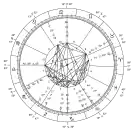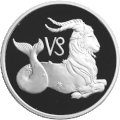Capricorn (astrology)
Capricorn (♑︎) is the tenth astrological sign in the zodiac out of twelve total zodiac signs, originating from the constellation of Capricornus, the goat.[2] It spans the 270–300th degree of the zodiac, corresponding to celestial longitude. Under the tropical zodiac, the sun transits this area from about December 22 to January 19.[2] In astrology, Capricorn is considered an earth sign, negative sign,[3][4] and one of the four cardinal signs. Capricorn is said to be ruled by the planet Saturn.
| Capricorn | |
|---|---|
 | |
| Zodiac symbol | Sea goat |
| Duration (tropical, western) | December 21 – January 20 (2022, UT1)[1] |
| Constellation | Capricornus |
| Zodiac element | Earth |
| Zodiac quality | Cardinal |
| Sign ruler | Saturn |
| Detriment | Moon |
| Exaltation | Mars |
| Fall | Jupiter |
| Astrology |
|---|
 |
| Background |
|
| Traditions |
|
| Branches |
|
| Astrological signs |
| Symbols |
|
There appears to be a connection between traditional characterisations of Capricorn as a sea goat and the Sumerian god of wisdom and waters,[5] who also had the head and upper body of a goat and the lower body and tail of a fish.[6] Later known as Ea in Akkadian and Babylonian mythology, Enki was the god of intelligence (gestú, literally "ear"), creation, crafts; magic; water, seawater and lakewater (a, aba, ab).[7]
Cultural significance
In India, the zodiac sign of Capricorn is celebrated as the Makara Sankranti festival,[8] also known in Nepal as Maghe Sankranti.[9] The Indian astronomical calendar is not based on the western Gregorian or Julian date keeping system. The Gregorian calendar has fixed days in a year and does not accommodate difference in the actual solar year. Therefore, the festival is celebrated on either of 14 or 15 January every year, when, as per the Indian astronomical calendar, the Sun actually enters the Capricorn sign.
Gallery
See also
- Astronomical symbols
- Chinese zodiac
- Circle of stars
- Cusp (astrology)
- Elements of the zodiac
References
Citations
- Astronomical Applications Department 2011.
- dictionary n.d., s.v. Capricorn.
- Mayo 1979, pp. 38–41.
- Ciubotaru 2008.
- Enki n.d.
- Adams 2014
- Augustin n.d.
- "Happy Makar Sankranti 2020: Makar Sankranti significance, history and why it's celebrated". Hindustan Times. January 15, 2020. Retrieved August 4, 2020.
- "Celebrating the fervour of Maghe Sankranti". The Kathmandu Post. January 10, 2020. Retrieved August 4, 2020.
Sources
- Astronomical Applications Department (2011). Multiyear Computer Interactive Almanac. 2.2.2. Washington DC: US Naval Observatory. Longitude of Sun, apparent geocentric ecliptic of date, interpolated to find time of crossing 0°, 30°.... The year stated applies to the December date; the year for the January date is one year greater.
- Adams, Leeuba Leshia (2014). "Astrology Vocation".
- Augustin, M. (n.d.). "Capricorn Mythology, what is it about?".
- "Capricorn". dictionary.com. n.d. Retrieved October 14, 2022.
- Ciubotaru, Dan (February 1, 2008). "Capricorn, Scorpio, Leo: In search of power". Archived from the original on March 11, 2008.
- "Enki". n.d. Archived from the original on 2015-05-28. Retrieved 2015-05-28.
- Mayo, Jeff (1979). Teach Yourself Astrology. London: Hodder and Stoughton.
External links
 The dictionary definition of Capricorn at Wiktionary
The dictionary definition of Capricorn at Wiktionary Media related to Capricorn at Wikimedia Commons
Media related to Capricorn at Wikimedia Commons- Warburg Institute Iconographic Database (over 300 medieval and early modern images of Capricorn)
